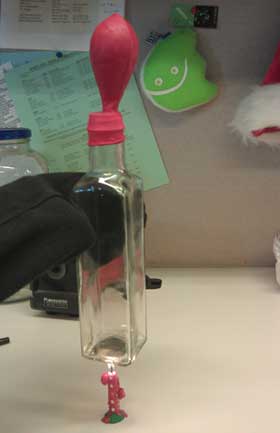Balloon Bottle
Physics in a Balloon: Balloon Bottle

It's like making a teeny tiny hot air balloon that doesn't go anywhere!
What you Need- A balloon
- A glass bottle
- A candle
- Clay
- Matches or a lighter
- An oven mitt or other appropriate heat barrier
- Place the balloon over the bottle opening.
- Set a candle upright on a nonflammable surface, using clay to make sure it stands upright.
- Light the candle
- Place the bottle and balloon apparatus over the flame, holding the bottle with your oven mitted hand.
Be careful not to get too close to the flame with the oven mitt and do NOT do this experiment without the supervision of an adult.
What’s Going On?
Inside the bottle are tiny gas particles that are floating around bumping into each other. When the glass bottle is put next to the flame, it heats up the gas inside the bottle. When the gas particles heat up they start to move around faster and faster, bumping into each other and the walls of the bottle more often and with greater force. Hot air is less dense, meaning that the space between the gas particles is greater because of this increased movement. The gas particles move around so quickly and with more force that the glass bottle isn’t big enough for the gas particles, so they look for a place where they can move. Hot air rises and the balloon is higher than the bottle, so the particles move into the balloon. The balloon is stretchy so when the gas particles get in the balloon, they push against the walls of the balloon, stretching out the balloon. Basically, when the gas particles heat up, the pressure inside the bottle and the balloon increases, which pushes against the inside of the balloon causing the balloon to fill with air, rise and expand.
- Fill the bottle with water and repeat the experiment. How does it affect the balloon?











